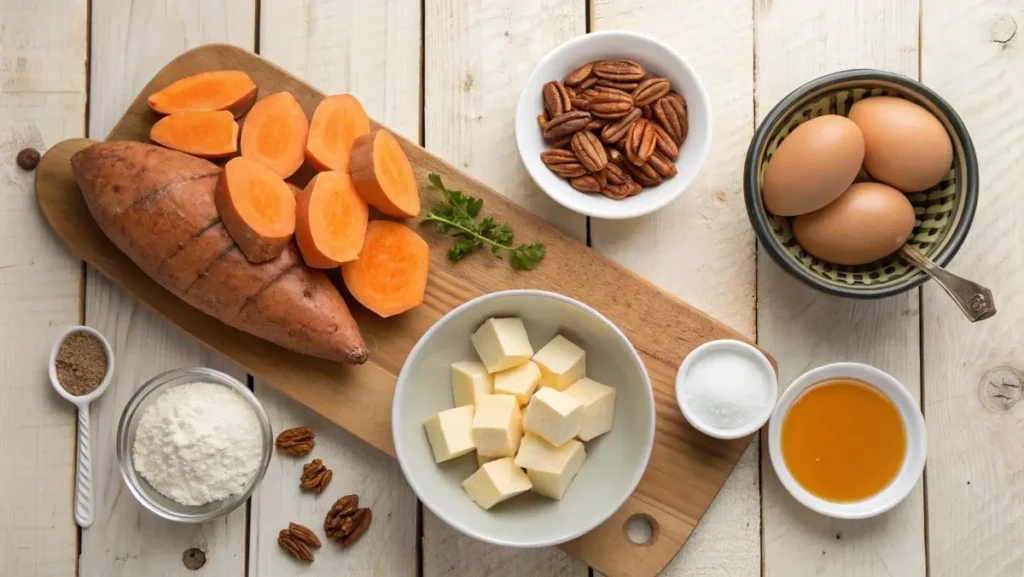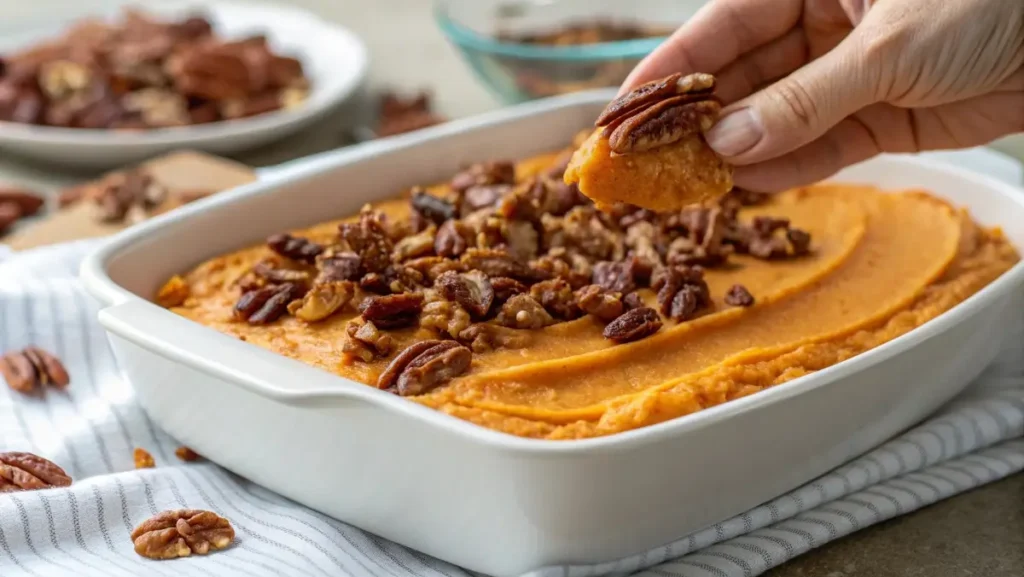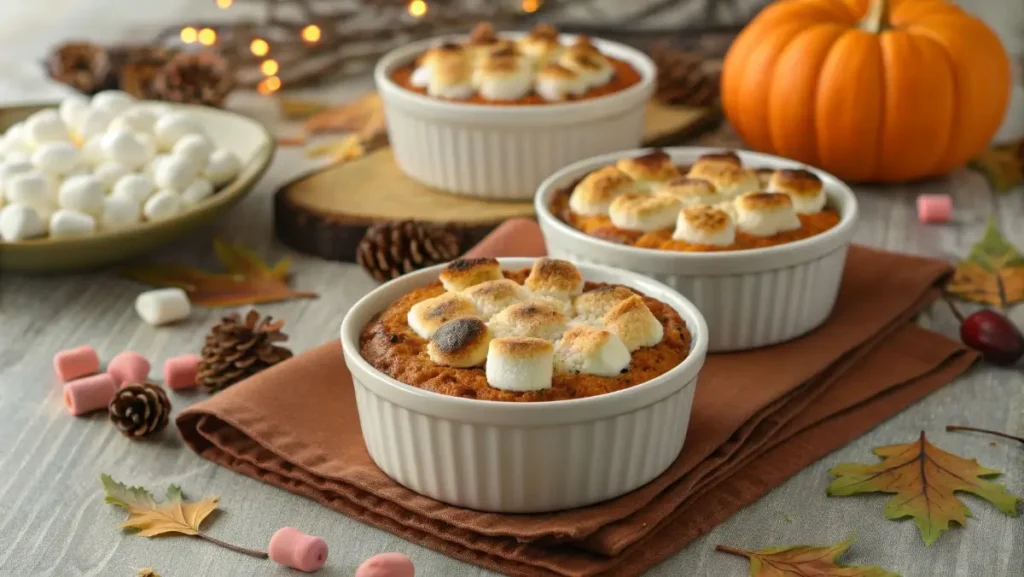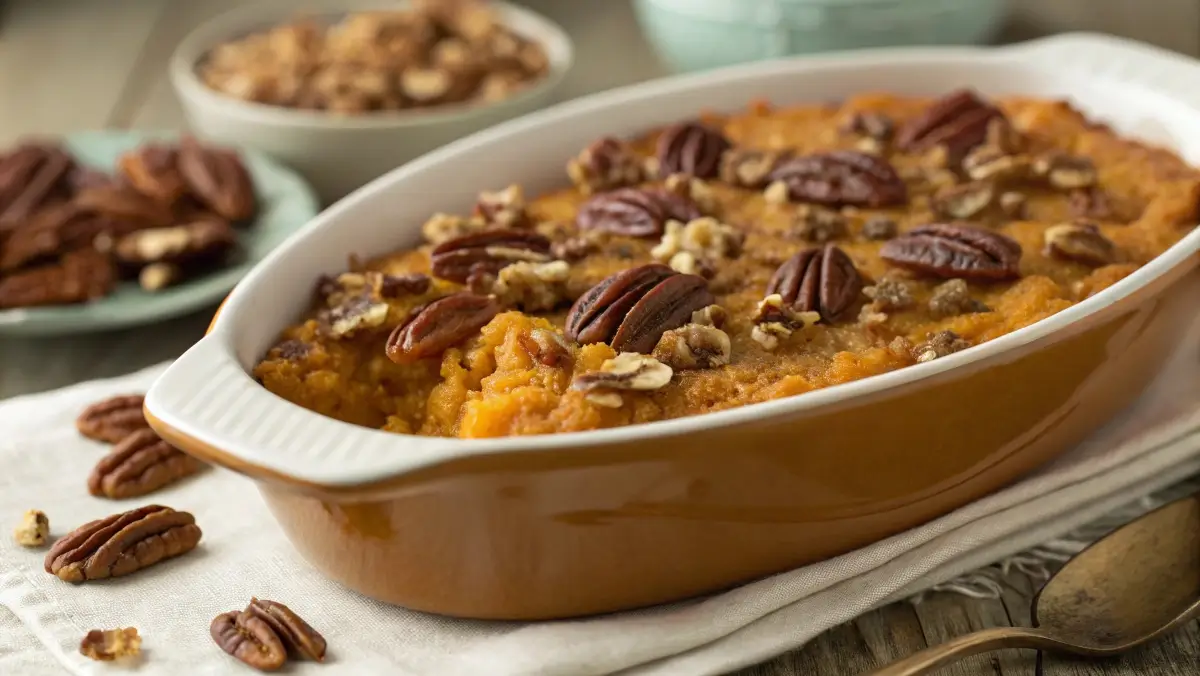Paula Deen Sweet Potato Casserole: The Best Southern Comfort Recipe to Try Today
When it comes to classic Southern comfort food, few dishes are as beloved as the Paula Deen sweet potato casserole. This creamy, spiced, and pecan-crusted favorite has become a staple at holiday tables across the United States—especially during Thanksgiving and Christmas. Known for its balance of sweet and savory, Paula’s version of this traditional dish brings together perfectly mashed sweet potatoes, warm spices like cinnamon and nutmeg, and a crunchy, buttery pecan topping that steals the show.
In this detailed guide, we’re diving deep into everything you need to know about this Southern gem—from its origin and ingredient breakdown to step-by-step cooking instructions, common troubleshooting tips, and delicious serving ideas. Plus, we’ll answer all your burning questions like “Can I prepare it the night before?” or “Why is my casserole too wet?”
Don’t miss our biscuit egg cheese casserole if you’re craving more warm and hearty side dishes like this one!
Table of Contents
Discovering Paula Deen’s Famous Sweet Potato Casserole
Who is Paula Deen and Why Her Sweet Potato Casserole is Iconic
Paula Deen, the queen of Southern cooking, has long been known for turning everyday ingredients into warm, comforting meals. Her sweet potato casserole embodies everything that makes Southern cuisine irresistible—simplicity, heartiness, and a touch of indulgence. This particular recipe became famous because it takes a humble vegetable like the sweet potato and transforms it into a decadent side dish that’s borderline dessert.
Originally featured on her television shows and website, this casserole gained widespread popularity for its ease of preparation and its wow factor when served at gatherings. The melt-in-your-mouth texture of the mashed sweet potatoes combined with the crunch of pecans is a signature that other versions often imitate but rarely match.
The Southern Roots of Sweet Potato Casserole
Sweet potatoes have deep roots in Southern cuisine, dating back to Native American agricultural traditions. As a naturally sweet, nutrient-dense vegetable, they became a household staple in Southern homes. It wasn’t long before they found their way into desserts and casseroles.
Southern sweet potato casserole as we know it today began appearing in early 20th-century cookbooks. The fusion of mashed sweet potatoes with sugar, spices, and crunchy toppings reflects the Southern knack for balancing flavor and texture. Paula Deen’s version pays homage to this tradition, with her unmistakable flair.
How This Dish Became a Thanksgiving Classic
For many families, sweet potato casserole is as essential as turkey on Thanksgiving. But why?
The answer lies in its versatility. It can serve as a savory side, a slightly sweet contrast to salty meats, or even a dessert substitute. Its make-ahead convenience and easy baking instructions make it a practical choice for busy holiday cooks.
Over time, thanks to celebrity chefs like Paula Deen, this dish moved beyond the Southern states and into kitchens across America. Now it’s a national favorite with countless regional twists.
Learn more about delicious Mexican cornbread casserole if you love a Southern casserole with a kick.
Ingredients Breakdown and Southern Flavor Combinations
Essential Ingredients in Paula Deen Sweet Potato Casserole
At the heart of every unforgettable Paula Deen sweet potato casserole is a well-balanced blend of ingredients that deliver both flavor and texture. Here’s a look at the must-haves:

| Ingredient | Purpose |
|---|---|
| Cooked and Mashed Sweet Potatoes | Provides the creamy base and natural sweetness |
| Granulated Sugar | Enhances the sweetness and balances the spices |
| Butter (Melted) | Adds richness and smooth texture |
| Eggs | Helps bind the casserole and adds structure |
| Vanilla Extract | Deepens the flavor profile with warm tones |
| Ground Cinnamon & Nutmeg | Classic warming spices for Southern depth |
| Heavy Cream or Milk | Makes the casserole extra creamy and moist |
These ingredients come together to create a luscious, smooth base that’s both comforting and indulgent. Paula’s recipe doesn’t cut corners—each component has a reason, and the result is harmony on a plate.
Don’t miss our guide to sourdough apple fritter bread if you’re craving warm, spiced holiday bakes!
Variations with Marshmallows, Pecans, and More
While Paula’s version focuses on a pecan-strewn, buttery brown sugar crumble topping, variations abound. Some prefer the marshmallow twist, while others go full nut-free. Here’s a comparison of popular topping styles:
| Topping Type | Flavor Profile | Texture |
|---|---|---|
| Pecan Crumble | Nutty, sweet, slightly crunchy | Crisp top with soft base |
| Marshmallow | Super sweet, gooey | Melts into a sticky, creamy layer |
| Oat Crumble | Earthy, hearty | Chewy and slightly crunchy |
| Nut-Free Brown Sugar Glaze | Sweet with no added crunch | Syrupy and smooth |
Paula’s pecan topping remains the gold standard because it adds that signature crunch without overpowering the dish’s sweetness.
Looking for inspiration? Try our delicious smoked salmon brine recipe for another Southern twist with bold flavor!
Choosing the Right Sweet Potatoes for Best Results
Not all sweet potatoes are created equal, and choosing the right variety is crucial to achieving that creamy, smooth base Paula Deen’s casserole is known for.
- Beauregard: Most commonly found in U.S. supermarkets. Deep orange flesh, sweet, and perfect for casseroles.
- Garnet: Slightly more moist and flavorful. Rich color and deeper taste.
- Jewel: Similar to Beauregard but with a lighter flavor and creamier texture.
Avoid white-fleshed sweet potatoes, which are starchier and less sweet, and steer clear of yams (they’re not true sweet potatoes).
Discover great ideas like sourdough breakfast recipes to round out your holiday menu.
Step-by-Step Instructions for Perfect Texture and Taste
How to Prepare Sweet Potatoes the Southern Way
Making the Paula Deen sweet potato casserole starts with properly cooking and prepping your sweet potatoes. The smoother and more flavorful your base is, the better the final dish will be.
Step-by-step instructions:
- Wash and peel 3–4 medium sweet potatoes (or about 3 cups when mashed).
- Boil in salted water for 15–20 minutes until fork-tender. You can also roast them at 400°F for enhanced flavor.
- Drain well to prevent excess moisture (this step helps avoid a watery casserole).
- Mash thoroughly using a potato masher or electric mixer for a creamy texture.
Tip: For extra flavor, roast your sweet potatoes instead of boiling. Roasting concentrates their sweetness and reduces water content.
Why this matters: Overcooked or under-seasoned sweet potatoes can make the whole dish feel flat. Southern cooking is all about flavor from start to finish.
Mixing and Layering: Creating the Perfect Base and Topping
Here’s how to mix and build the perfect casserole that’s rich, spiced, and finished with Paula’s signature pecan topping.
Sweet Potato Mixture (Base)
In a large bowl, combine the following:
- 3 cups mashed sweet potatoes
- 1 cup granulated sugar
- ⅓ cup melted butter
- 2 large eggs (room temp)
- 1 tsp vanilla extract
- 1 tsp ground cinnamon
- ¼ tsp ground nutmeg
- ¼ cup heavy cream or whole milk
Blend until smooth using a hand mixer. The goal is a creamy, lump-free base with balanced sweetness and a rich, spiced undertone.
Pour into a greased 1.5-quart casserole dish and spread evenly.

Pecan Topping (Crunchy Crust)
Mix together in a separate bowl:
- 3 tbsp melted butter
- 1 cup brown sugar
- ⅓ cup all-purpose flour
- 1 cup chopped pecans
Use a fork to blend into a coarse crumble. Sprinkle evenly over the sweet potato base. Don’t pack it down—let it sit loose for a crispy finish.
Tip: If you want a thicker crunch, double the topping ingredients.
Tips for a Crispy Pecan Crust and Creamy Filling
A good casserole is about balance—smooth underneath and crispy on top. Here’s how to nail both:
- Don’t overmix the base after adding eggs—just enough to blend.
- Bake at 325°F for 25–30 minutes. The top should be lightly golden and bubbling at the edges.
- Let it rest 10 minutes before serving so the structure sets.
- Avoid covering it during baking unless your topping starts to burn (then use foil loosely).
Don’t miss our delicious Mexican cornbread casserole for another casserole dish with Southern charm.
Make-Ahead Tips and Storage Guide
Can I Prepare My Sweet Potato Casserole the Night Before?
Absolutely—and Paula Deen herself would likely encourage it. One of the beauties of this dish is how well it holds up when prepped ahead of time.
How to make it ahead:
- Prepare the sweet potato mixture and spread it into the greased casserole dish.
- Make the topping, but store it separately in an airtight container.
- Cover the casserole base tightly with plastic wrap or foil and refrigerate overnight.
- Before baking, add the topping, allow the dish to sit at room temperature for about 30 minutes, then bake according to the recipe instructions.
This make-ahead method ensures a fresh, crunchy topping while saving you valuable time on the big day.
Bonus: The flavor intensifies slightly overnight, making it even better the next day!
Looking for more time-saving holiday dishes? Check out this delicious smoked salmon brine recipe that can also be made ahead.
Refrigeration vs. Freezing: What Works Best?
If you’re planning further ahead, freezing is an option—but it requires a few tweaks.
| Storage Method | How Long It Lasts | Best Practices |
|---|---|---|
| Refrigerator | Up to 3 days | Cover tightly with foil or use airtight glassware |
| Freezer (Unbaked) | Up to 3 months | Leave topping off and add fresh before baking |
| Freezer (Baked) | 1–2 months | Wrap well in foil, thaw overnight in fridge before reheating |
Important: Don’t freeze with marshmallow topping—marshmallows don’t reheat well.
How to Reheat Without Losing Flavor or Texture
Whether you’re reheating leftovers or a prepped casserole, keeping the creamy center and crunchy topping is key.
Reheating tips:
- From the fridge: Bake at 300°F for 15–20 minutes, uncovered.
- From the freezer (thawed): Bake at 325°F for 25–30 minutes.
- If the topping looks too soft, broil for 2–3 minutes at the end—but watch closely to avoid burning.
Avoid using the microwave—it tends to make the topping soggy and can overcook the edges.
Don’t miss our irresistible oatmeal cream pies for dessert ideas that reheat like a dream too!
Cooking, Timing, and Temperature Essentials
How to Know When Sweet Potato Casserole is Ready
A perfectly baked Paula Deen sweet potato casserole should have a golden-brown topping, slight bubbling around the edges, and a center that’s set—not jiggly or overly wet.
Visual and textural signs it’s done:
- The topping is crisp and golden (not pale or doughy).
- The edges are slightly bubbling—a sign that the sugars and butter are caramelizing.
- A toothpick inserted 1 inch from the edge should come out clean.
Tip: If the center still feels soft after 30 minutes, let it go another 5–10 minutes but keep an eye on the topping.
Don’t miss our biscuit egg cheese casserole for another great oven-baked Southern dish.
Does Sweet Potato Casserole Need to Be Covered?
No, this dish should not be covered during baking unless the topping starts to brown too quickly. Keeping it uncovered allows the topping—especially Paula’s pecan crumble—to crisp up beautifully.
However, if you’re:
- Using a marshmallow topping: Tent it loosely with foil during the first 15 minutes to avoid burning.
- Baking from frozen: Cover with foil for the first half, then uncover to crisp the topping.
Reminder: Always place the casserole on the middle rack to ensure even cooking.
Avoiding Overbaking or Drying Out the Top Layer
Overbaking can cause the top to turn dry, the edges to harden, and the inside to lose its creamy softness.
Here’s how to avoid that:
- Stick to 25–30 minutes at 325°F for fresh-baked.
- Use an oven thermometer—many ovens run hot or cold.
- Rotate the dish halfway through for even browning.
- Let it rest for 10–15 minutes before serving—this helps the inside firm up without drying out.
Pro Tip: Use a glass casserole dish for even heat distribution and easier doneness checks.
Learn more about delicious Mexican cornbread casserole for another bake-perfect Southern comfort side.
Troubleshooting Common Mistakes
Even a classic like Paula Deen sweet potato casserole can go sideways if you’re not careful. From mushy textures to unexpected white residue, this section addresses the most common casserole issues and offers simple, practical fixes.
Why is My Sweet Potato Casserole Wet?
A wet or runny casserole is one of the most frequent complaints. Here’s why it happens—and how to fix it:
Common causes:
- Overboiled sweet potatoes: Boiling adds extra water that doesn’t evaporate in baking.
- Skipping the drain + mash step: If you don’t thoroughly drain and mash the sweet potatoes, they’ll release water during baking.
- Too much dairy: Adding more than ¼ cup of milk or cream can thin the base too much.
Fix it next time:
- Roast instead of boil for a dryer, more intense sweet potato flavor.
- Reduce liquid or let the mash sit uncovered for 10 minutes before mixing in other ingredients.
- Add 1–2 tbsp of flour or a beaten egg to help thicken the base if it’s too loose.
Can You Overcook Sweet Potatoes for Casserole?
Yes, you can overcook sweet potatoes, and it affects both texture and flavor.
What happens when they’re overcooked:
- The sugars start to caramelize too much, turning bitter.
- The potatoes can absorb excess water if boiled too long.
- Over-roasted potatoes may become stringy or tough.
How to avoid it:
- Boil just until fork-tender (usually 15–20 minutes).
- For roasting, keep it to 375°F for 45–50 minutes max.
- Check them early, especially if you’re working with small or thin potatoes.
Why Is White Liquid Coming Out of My Sweet Potato?
If you’ve ever seen a milky or white sap-like liquid coming from your sweet potatoes—don’t worry, it’s natural.
What it is:
That pale film is simply a mix of natural starches and sugars released from the sweet potatoes. It’s completely safe and doesn’t affect flavor.
What to do:
- Wipe it off with a paper towel before roasting or boiling.
- If it appears in the finished casserole, just stir the mix well before baking—it’ll blend in and disappear during cooking.
Sweet Potato Casserole Variations and Creative Twists
While the classic Paula Deen sweet potato casserole is beloved just the way it is, there are plenty of ways to customize this dish to suit your dietary needs, event, or flavor cravings. Let’s explore a few delicious ways to make it your own.

Marshmallow-Topped vs. Pecan Crumble: Southern Showdown
The biggest debate in Southern kitchens: to marshmallow or not to marshmallow?
| Topping Type | Taste Profile | Texture | Best For |
|---|---|---|---|
| Pecan Crumble (Paula’s) | Nutty, caramelized | Crunchy, buttery | Adults, traditional Southern fans |
| Marshmallow | Sweet, gooey | Sticky, melty | Kids, dessert-style presentation |
| Combo (Pecan + Marshmallow) | Balanced sweet & crunch | Rich, layered texture | Crowd-pleasers & holiday tables |
Tip: Add mini marshmallows in the last 10 minutes of baking so they don’t burn or deflate.
Making It Gluten-Free, Dairy-Free, or Vegan
Want to make this dish accessible to everyone at the table? Here’s how to adapt the classic without losing flavor.
Gluten-Free Version:
- Use certified gluten-free oats or almond flour instead of all-purpose flour for the crumble topping.
- Make sure your vanilla extract and spices are certified gluten-free—most are, but it’s always best to confirm by checking the labels.
Dairy-Free Version:
- Swap butter with plant-based alternatives like Earth Balance.
- Use almond milk, oat milk, or coconut cream instead of heavy cream.
Vegan Version:
- Use all of the above dairy-free options.
- Replace eggs with flax eggs (1 tbsp ground flaxseed + 3 tbsp water = 1 egg).
- Sweeten naturally with maple syrup instead of white sugar for added depth.
Want more allergen-friendly recipes? Check out our gluten-free summer salads for vibrant, fresh sides.
Mini Sweet Potato Casserole Cups for Parties
Hosting a potluck or buffet-style holiday party? Mini casseroles are the way to go! They’re cute, practical, and just as delicious.
How to make them:
- Use a muffin tin or individual ramekins.
- Grease and fill each ¾ of the way with sweet potato mixture.
- Top with pecan crumble or a single marshmallow.
- Bake at 325°F for 15–18 minutes (until tops are golden).
- Cool 5 minutes before serving.
These are ideal for portion control and make a beautiful presentation on your holiday table.
Discover great ideas like our sourdough apple fritter bread to round out your seasonal spread.
Pairing Ideas and Serving Suggestions
The rich and comforting flavors of Paula Deen sweet potato casserole make it a star on its own—but pair it with the right dishes, and you’ve got a complete Southern-style feast that’ll have everyone going back for seconds.
Best Dishes to Serve with Paula Deen Sweet Potato Casserole
Here’s how to round out your holiday or Sunday dinner with complementary textures and flavors.
| Main Course | Why It Works |
|---|---|
| Glazed ham | Balances sweet casserole with savory meat |
| Roasted turkey or chicken | A classic Thanksgiving pairing |
| Smoked brisket or pulled pork | Adds a bold, smoky contrast |
| Herb-crusted pork tenderloin | Earthy flavors play well with sweetness |
| Side Dishes | Pairing Notes |
|---|---|
| Green bean almondine | Offers crunch and freshness |
| Garlic mashed potatoes | Classic pairing with a soft texture |
| Buttermilk cornbread | Southern classic to mop up all flavors |
| Cranberry relish | Tartness cuts through richness |
Looking for inspiration? Try this delicious Mexican cornbread casserole as a spicy-sweet side addition.
Presentation Tips to Wow Your Guests
We eat with our eyes first, so presenting your Paula Deen sweet potato casserole with flair makes all the difference.
Make it pop on your table:
- Serve in a white ceramic baking dish for color contrast.
- Add extra pecans on top for garnish just before serving.
- Lightly dust with cinnamon or nutmeg for a rustic, warm appearance.
- Pair with sprigs of rosemary or a few cranberries on the side for a holiday vibe.
Want something cozy for the morning after? Don’t miss our sourdough breakfast recipes for a comforting start to your day.
User Reviews, Memories, and Family Traditions
The beauty of Paula Deen sweet potato casserole isn’t just in its creamy texture or caramelized pecan topping—it’s in the memories it helps create. This dish has earned its place on Thanksgiving spreads, Sunday suppers, and even wedding buffets. Below, we take a warm and heartfelt look at how home cooks across the country are making this Southern classic their own.
Real Stories from Home Cooks
Across forums, recipe sites, and social media, thousands of home cooks have shared glowing stories about Paula Deen’s recipe. Here are a few standouts:
“This casserole reminds me of my grandmother’s kitchen. I make it every Thanksgiving, and there’s never a spoonful left.” – Jessica from Georgia
“It was my first time hosting Friendsgiving. I followed Paula’s sweet potato casserole recipe exactly, and people literally asked for the recipe. Success!” – Anthony from Oregon
“I’ve made it gluten-free and vegan for my daughter, and even the meat-eaters went in for seconds. It’s now our holiday go-to.” – Latasha from North Carolina
The common thread? It’s reliable, nostalgic, and delicious.
How This Recipe Becomes a Holiday Staple
Here’s why this dish continues to be passed down and made year after year:
- Make-ahead ease: You can prep it the night before and focus on other dishes.
- Comfort factor: The warm, sweet, spiced filling delivers major nostalgic vibes.
- Versatility: Works as a side or dessert. Kids love the marshmallows; adults love the pecans.
- Crowd pleaser: It suits almost any dietary need with easy tweaks.
Whether it’s your first time making this dish or your fiftieth, it always delivers that homemade-from-the-heart feel.
Creating Your Own Twist on Paula’s Classic
Many families adapt Paula’s base recipe to reflect their own taste or heritage:
| Family Twist | Common Customizations |
|---|---|
| Cajun-style casserole | Add cayenne, paprika, or smoked chili powder |
| Caribbean sweet potato pie | Add coconut milk and cinnamon-sugar crust |
| Midwestern style | Use crushed cornflakes or pretzels for topping |
| Low-sugar variation | Swap sugar with maple syrup or mashed banana |
Pro tip: Keep a record of your yearly changes—your custom version could become a family heirloom recipe one day.
Discover more Southern favorites like our delicious smoked salmon brine that also bring generations together.
Conclusion
There’s a reason Paula Deen sweet potato casserole continues to shine on dinner tables across America—it’s the perfect mix of nostalgic comfort and Southern decadence. From its velvety sweet potato base to its buttery, nutty topping, this dish is more than just a side; it’s a holiday tradition waiting to happen.
Whether you’re making it for Thanksgiving, a Sunday family dinner, or a potluck with friends, you now have every tip, variation, and troubleshooting trick to ensure it turns out flawless—every single time. And if you’re feeding a crowd with varied tastes or dietary needs, this recipe is flexible enough to accommodate them all.
So go ahead: preheat the oven, grab those sweet potatoes, and create something unforgettable.
Looking for even more cozy dishes? Explore our full guide to gluten-free summer salads for lighter options to balance your next Southern spread.
FAQs
Can I prepare my sweet potato casserole the night before?
Yes! You can assemble the base ahead and store the topping separately in the fridge. Combine them just before baking for the freshest taste and texture.
How to know when sweet potato casserole is ready?
It’s done when the topping is golden brown, the edges are bubbling, and the center is set. Insert a toothpick—it should come out mostly clean.
Does sweet potato casserole need to be covered?
No. Bake it uncovered to allow the pecan or marshmallow topping to crisp. Only use foil if the topping browns too quickly.
Why is my sweet potato casserole wet?
This often happens when the sweet potatoes were overboiled or not drained well. Excess moisture causes the base to turn runny.
Can you overcook sweet potatoes for casserole?
Yes. Overcooking can lead to waterlogged, mushy, or even bitter sweet potatoes. Boil until just fork-tender or roast instead.
Why is white liquid coming out of my sweet potato?
That’s just natural starch and sugar from the potato. It’s harmless and can be wiped away before cooking.

